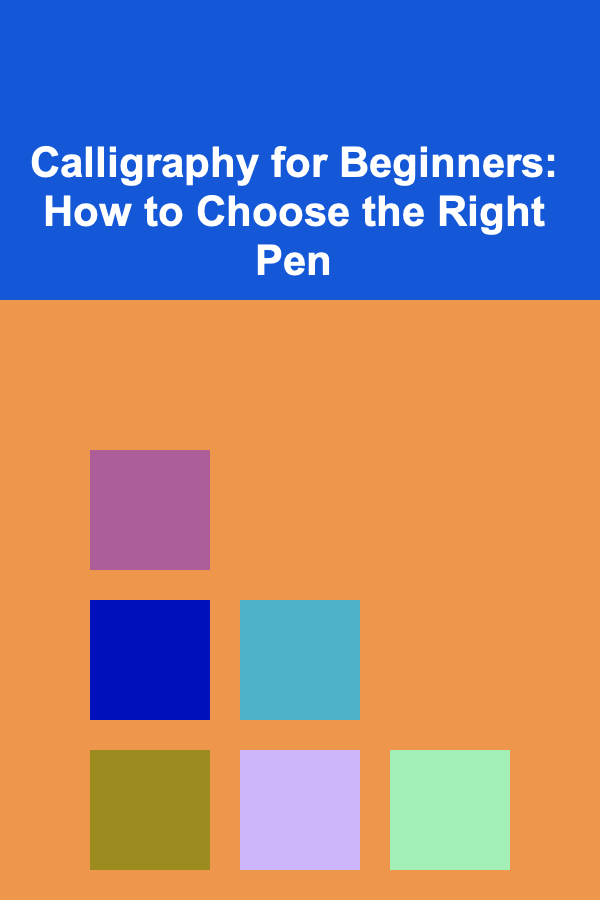
Calligraphy for Beginners: How to Choose the Right Pen
ebook include PDF & Audio bundle (Micro Guide)
$12.99$5.99
Limited Time Offer! Order within the next:

Calligraphy, the art of beautiful handwriting, has been practiced for centuries and continues to be a popular hobby and skill today. Whether you're looking to enhance your artistic abilities, create elegant invitations, or simply enjoy the process of writing, choosing the right calligraphy pen is essential for getting started. The right pen will not only help you achieve your desired style, but it will also make the process smoother and more enjoyable.
In this article, we'll explore the key factors you should consider when choosing a calligraphy pen, the different types of calligraphy pens available, and some practical advice for beginners to help you make an informed decision.
Understanding the Basics of Calligraphy
Before diving into the specifics of choosing a calligraphy pen, it's essential to have a basic understanding of what calligraphy is and what makes it unique. Calligraphy is the art of creating decorative, stylized writing using specialized tools. The key difference between calligraphy and regular handwriting is the use of varied stroke widths, achieved by the application of different amounts of pressure on the pen. This variability in stroke width is what gives calligraphy its characteristic elegance and fluidity.
The process involves forming letters, words, or entire texts with graceful, often elaborate, letterforms. Different styles of calligraphy have evolved over time, each with its own set of rules, techniques, and tools. For beginners, the most important consideration is learning the fundamentals of calligraphy, which include control, form, and consistency.
Why Choosing the Right Pen Matters
The pen you choose for calligraphy can make a significant difference in the results you achieve. The right pen can make the process easier, while the wrong one can lead to frustration. There are several factors to consider when choosing a pen for calligraphy:
- Control: Calligraphy requires precise control over the pen, which allows for consistent stroke thickness and smooth letterforms.
- Comfort: Since you'll be holding the pen for extended periods, comfort is key to avoiding hand fatigue and discomfort.
- Ink Flow: A good pen should offer smooth ink flow that doesn't blot or skip.
- Line Thickness: Different pens create different line thicknesses, which can affect the overall look and style of your calligraphy.
- Budget: Calligraphy pens come in a range of prices. As a beginner, you may want to opt for something affordable, but don't sacrifice quality for the price.
Now that we understand the significance of choosing the right pen, let's explore the different types of calligraphy pens available and how each one can serve a different purpose.
Types of Calligraphy Pens
There are several types of pens that can be used for calligraphy, each offering its own unique features. Understanding the different types of pens and their characteristics is the first step toward finding the right one for your needs.
1. Fountain Pens
Fountain pens are among the most popular choices for calligraphy, especially for beginners. They have a built-in ink reservoir that feeds ink to the nib, making them convenient and easy to use.
Pros:
- Smooth writing experience: Fountain pens provide a smooth writing experience and require little effort to write.
- Variety of nibs: Fountain pens come with a wide range of nibs, allowing you to experiment with different line thicknesses.
- No need for ink bottles: Most fountain pens come with refillable ink cartridges, making them mess-free and easy to use.
Cons:
- Limited to certain styles: While fountain pens are excellent for basic calligraphy, they may not be suitable for more advanced styles that require thicker strokes and more flexibility.
Best For:
- Beginners looking for an easy-to-use, low-maintenance pen for practicing basic calligraphy styles like Copperplate or Spencerian.
2. Dip Pens
Dip pens are traditional tools used by calligraphers and artists for centuries. These pens require you to dip the nib into an ink bottle, making them versatile and perfect for a wide variety of calligraphy styles.
Pros:
- Wide range of nibs: Dip pens offer a variety of nibs that can produce thin and thick strokes, giving you flexibility in your writing.
- Customizable ink flow: You control how much ink the nib picks up, which can result in a more personal, customized writing style.
- Variety of nibs: With dip pens, you can experiment with different nibs, such as pointed nibs, broad-edged nibs, and stub nibs.
Cons:
- Ink needs to be replenished: Since you need to dip the nib into ink regularly, the process can be slower than using a fountain pen.
- Can be messy: The ink-dipping process can be messy, especially for beginners.
Best For:
- Intermediate or advanced calligraphers who want to try different nibs and explore more advanced styles like Gothic, Italic, or Modern Calligraphy.
3. Brush Pens
Brush pens are often used for brush calligraphy and modern script. These pens feature a flexible brush tip that mimics the movements of a traditional paintbrush.
Pros:
- Versatile strokes: The brush tip allows for a wide variety of strokes, including thick, thin, and even variable lines.
- Easy to use: Brush pens are often easier to use than traditional brushes and inks, making them great for beginners.
- Portable: Since the ink is contained in the pen, there's no need to carry separate ink bottles.
Cons:
- Less precision: While brush pens are great for casual calligraphy and brush lettering, they may lack the precision of dip pens or fountain pens for more detailed work.
Best For:
- Beginners interested in modern calligraphy or brush lettering, as they offer an easy transition into calligraphy without the need for specialized ink or brushes.
4. Ballpoint Pens
While not traditionally associated with calligraphy, ballpoint pens can be used for some basic calligraphy styles, especially for those who prefer a more minimalist approach.
Pros:
- Widely available: Ballpoint pens are inexpensive and easy to find, making them accessible to everyone.
- Convenient: No need to worry about ink refills or messy setups.
Cons:
- Limited line variety: Ballpoint pens offer limited variability in stroke width, which means they're less suitable for classic calligraphy styles.
- Less artistic: The smoothness of ballpoint pens may lack the charm and flow of other calligraphy pens.
Best For:
- Beginners who just want to practice basic letterforms and who may not want to invest in more specialized calligraphy tools at the start.
5. Gel Pens
Gel pens can be a good alternative for beginners who want to experiment with calligraphy without committing to traditional pens.
Pros:
- Smooth flow: Gel pens offer a smooth ink flow that makes writing effortless.
- Color variety: Gel pens come in many colors, offering creative freedom.
Cons:
- Less flexibility: Like ballpoint pens, gel pens don't offer much flexibility in stroke thickness, limiting their use for more advanced styles.
- Ink tends to smudge: Depending on the ink, gel pens may take a little longer to dry, which can cause smudging, especially on glossy paper.
Best For:
- Beginners who want to experiment with colorful calligraphy or who prefer a smoother, less technical writing experience.
How to Choose the Right Pen for You
Choosing the right calligraphy pen depends on several factors, including your personal preferences, the style of calligraphy you want to practice, and your level of experience. Here are some practical tips to help you make the right decision:
- Consider Your Calligraphy Style: Different pens are better suited for different styles. For example, a dip pen with a broad-edged nib is ideal for classic calligraphy styles like Gothic or Italic, while a brush pen is better for modern calligraphy or brush lettering.
- Assess Your Comfort Level: If you're new to calligraphy, you may prefer a fountain pen or brush pen, as these require less technical skill than dip pens.
- Think About Portability: If you need a pen that you can take with you, a fountain pen or gel pen might be the most convenient. A dip pen, while versatile, can be messy and require additional ink supplies.
- Budget: There are calligraphy pens available for all budgets. If you're just starting out, a basic fountain pen or brush pen may be a cost-effective option. As you progress, you may want to invest in higher-quality pens or dip pens for more intricate work.
Conclusion
Choosing the right calligraphy pen is an important step in your calligraphy journey. By considering the type of calligraphy you want to practice, your comfort level, and your budget, you can find a pen that fits your needs and helps you achieve your desired results. Whether you start with a fountain pen, dip pen, or brush pen, remember that calligraphy is an art form that takes time and practice. The pen you choose will be your tool for expressing your creativity and enhancing your writing skills, so take the time to experiment and find the one that works best for you.
Happy writing!
Reading More From Our Other Websites
- [Organization Tip 101] How to Use Mindful Affirmations for Positive Thinking
- [Home Renovating 101] How to Use Home Renovation Apps to Streamline Your Projects
- [Trail Running Tip 101] Nature's Pulse: Using Trail Sounds as a Moving Mantra During Runs
- [Home Rental Property 101] How to Determine if Houses for Rent with a Built-In Sound System Are Worth the Extra Cost
- [Home Holiday Decoration 101] How to Decorate with Holiday-Themed Throw Pillows
- [Home Budget Decorating 101] How to Turn Your Backyard into a Stylish Space on a Budget
- [Personal Finance Management 101] How to Invest Like a Millennial: Tips and Strategies
- [Personal Investment 101] How to Develop a Personal Investment Plan That Fits Your Financial Goals
- [Trail Running Tip 101] Top 7 Scenic Solo Trail-Running Destinations You Must Explore
- [Personal Investment 101] How to Understand Bonds and Their Role in Your Portfolio

How to Make Money Online as a Speech-Language Pathologist: 10 Actionable Ideas
Read More
How to Organize Your Car with Reusable Bags and Containers
Read More
How to Train Your Brain to Break Bad Habits
Read More
How to Learn to Play by Ear on Any Instrument
Read More
How to Track Medical Expenses for International Travel
Read More
10 Tips for Encouraging Independence: A Toddler Development Planner
Read MoreOther Products

How to Make Money Online as a Speech-Language Pathologist: 10 Actionable Ideas
Read More
How to Organize Your Car with Reusable Bags and Containers
Read More
How to Train Your Brain to Break Bad Habits
Read More
How to Learn to Play by Ear on Any Instrument
Read More
How to Track Medical Expenses for International Travel
Read More